Re-Defining, Analyzing and Predicting Persistence Using Student Events in Online Learning †
Abstract
Featured Application
Abstract
1. Introduction
- O1.
- Propose a model to measure students’ local persistence based on their interactions in a digital platform with online exercises.
- O2.
- Analyze the prevalence of the local persistence.
- O3.
- Analyze the evolution of local persistence over the time.
- O4.
- Analyze how local persistence is related to global persistence, and other variables about students’ performance and engagement with videos.
- O5.
- Analyze the predictive power of local persistence in predictive models to predict global persistence and students’ performance.
2. Related Work
2.1. Global Persistence
2.2. Local Persistence
3. Materials and Methods
3.1. Context and Data Collection
3.2. Variables and Measures
- Global persistence: It is a binary variable to indicate whether or not a student has activity in the course and/or completes it. It is directly related with the term dropout, as students who do not complete the course (i.e., they are not persistent in a global sense) can count as a dropout. As dropout can be measured in many different ways and its definition may be sometimes difficult because some students can be inactive for a period and then continue the course [29], two measures are considered and discussed throughout the paper.
- ○
- Definition related to activity: Students are persistent at the global level if they engage with the course (i.e., by watching a video and/or attempting an exercise) at least once every fortnight. In other words, they are not persistent when they do not interact with the course for two consecutive weeks. As there can be periods where students do not necessarily need to interact (e.g., public holidays and/or periods where the instructor wants to focus in other activities different from the SPOCs), weeks where less than 10% of students interact are not considered towards the calculation of global persistence.
- ○
- Definition related to completion: Students are persistent at the global level when they complete most of the exercises, regardless when they complete them. In this case, 75% of activities need to be completed to be persistent at the global level, although this threshold could be adaptable in other contexts. In this case, it can be reasonable as it is used in other well-known platforms, such as MiríadaX (https://miriadax.net/en/faq?faqid=8635212), which requires completing 75% (and passing, which is not required here) of modules to get certification of participation. This definition differs the former (definition related to activity) because this definition focuses on students’ completion of activities (regardless the period), while the former focuses on accessing the SPOC (regardless activities are done or not).
- Local persistence: It is a continuous variable that measures to what extent students continue attempting an exercise until getting the correct answer once they have answered it incorrectly. It is considered as “local” because it is focused on the atomic unit of an exercise, while global persistence focuses on the whole course. Section 4 provides more details about the computation of this variable. For computing this variable, all interactions with exercises are needed to know the outcome (correct/incorrect) for each attempt and students’ actions after incorrect attempts. However, lack of details about course context are an important limitation because some contexts do not allow computing local persistence (e.g., students cannot show persistence if only one attempt is allowed in the exercise).
3.3. Analytical Methods
4. Description of the Model to Identify Local Persistence
- If students get the answer right in the first attempt, no local persistence is shown because there is not a situation where an answer is incorrect (i.e., there is not a difficulty the student should address) and the student should decide whether attempting the exercise again or not (to show local persistence). However, this fact does not mean that students are not persistent. Therefore, events where the answer is correct in the first attempt are excluded. Similarly, re-attempts of correct exercises are excluded because the student already got the correct answer.
- Students show more local persistence if they need more attempts to solve the exercise, but they should not be penalized if they solve the exercise with few attempts.
- n: Indicates the number of exercises the student has attempted.
- i: Represents a particular exercise the student has attempted. For example, represents the first exercise the student took in the SPOC.
- : Indicates the total number of times the student tried exercise i. The equation has the term to exclude the first attempt, as no persistence is shown in that time (as the student does not decide whether continue or not after difficulties)
- : Binary value which indicates whether the student managed to get the correct answer of exercise i (, the maximum grade) or not (). For exercises which may admit partial grades (e.g., checkboxes), if the exercise is totally correct and otherwise.
- penalty: Variable to penalize when students do not get the correct answer of the exercise. This way, when the answer is correct, the numerator is not changed, but the denominator is increased to decrease the overall value of local persistence. When the answer is correct, as , the penalty is avoided.
- stop: Represents the maximum number of attempts that can be summed for each exercise. This is used to avoid single exercises with many attempts have a huge weight that may make local persistence to be high even when students never attempt incorrect exercises.
5. Results
5.1. Analysis of Prevalence of Local Persistence
- Profile 1 (). They are the students who most complete videos and attempt exercises on average, and the grade of the exercises they attempt is 0.84 on average, which is good. However, their local persistence is 0.53 on average. This means that they have their exercises right at first attempt many often (67% of times) so their average grade is good, but they are not always persistent at the local level. In fact, from the 33% of exercises they have it wrong at first attempt, they eventually solve correctly 16%, which means that they are persistent at the local level about half of the times.
- Profile 2 (). They are students with very high local persistence and average grade in the exercises they try. This means that they want to complete what they start. However, they engage with few exercises and videos on average. Instructors should motivate these students to engage more with the SPOC.
- Profile 3 (): They are good students. They have very high local persistence and average grade, which means that they almost always complete the exercises they start. They also complete a significant part of the SPOC on average, although they could engage with more videos/exercises.
- Profile 4 (): They are students with medium local persistence (average is 0.52 and most values are between 0.32 a 0.71) and their average grade is 0.86, which is good. They engage with about 40% of videos and exercises. Therefore, this is a group of average students, which engage with parts of the SPOC and get many exercises right at first attempt (69% on average), but they may not care so much about getting everything correct if their average grade is high. They are similar to Profile 1, although they engage with less part of the SPOC on average.
- Profile 5 (): They are the most critical students. Their local persistence is relatively low on average (0.39), and the third quartile is only 0.5. Moreover, these students only engage with 16% of videos and exercises of the SPOC. Their average grade is the lowest among all profiles (0.76). These students get 58% of the exercises right at first attempt, but they only eventually complete 72% of the exercises (an additional 14%), which means that they do not usually keep on trying their exercises to get the correct answer. Instructors should try to motivate them to work harder on the SPOC to engage with more activities and complete the exercises they start.
5.2. Analysis of the Evolution of Local Persistence over Time
5.3. Relationship between Local Persistence and Global Persistence, Students’ Performance and Engagement with Videos
5.4. Prediction of Global Persistence and Students’ Performance Using Local Persistence
6. Conclusions
Author Contributions
Funding
Conflicts of Interest
References
- Mikulecký, P. Smart Environments for Smart Learning. In Proceedings of the 9th International Scientific Conference on Distance Learning and Applied Informatics, Sturovo, Slovakia, 2–4 May 2012; pp. 213–222. [Google Scholar]
- Verbert, K.; Duval, E.; Klerkx, J.; Govaerts, S.; Santos, J.L. Learning Analytics Dashboard Applications. Am. Behav. Sci. 2013, 57, 1500–1509. [Google Scholar] [CrossRef]
- Feng, M.; Heffernan, N.; Koedinger, K. Student modeling in an intelligent tutoring system. In Intelligent Tutoring Systems in E-Learning Environment: Design Implementation and Evaluation, 1st ed.; Stankov, S., Glavinić, V., Rosić, M., Eds.; IGI Global: Hershey, PA, USA, 2011; pp. 208–236. [Google Scholar]
- Spector, J.M. Conceptualizing the emerging field of smart learning environments. Smart Learn. Environ. 2014, 1, 2. [Google Scholar] [CrossRef]
- Hwang, G.J. Definition, framework and research issues of smart learning environments-a context-aware ubiquitous learning perspective. Smart Learn. Environ. 2014, 1, 4. [Google Scholar] [CrossRef]
- Moreno-Marcos, P.M.; Alario-Hoyos, C.; Muñoz-Merino, P.J.; Delgado Kloos, C. Prediction in MOOCs: A review and future research directions. IEEE Trans. Learn. Technol. 2019, 12, 384–401. [Google Scholar] [CrossRef]
- Muenks, K.; Wigfield, A.; Yang, J.S.; O’Neal, C.R. How True is Grit? Assessing Its Relations to High School and College Students’ Personality Characteristics, Self—Regulation, Engagment, and Achievement. J. Educ. Psychol. 2017, 109, 599–620. [Google Scholar] [CrossRef]
- Kuh, G.D.; Crue, T.M.; Shoup, R.; Kinzie, J.; Gonyea, R.M. Unmasking the effects of student engagement on first-year college grades and persistence. J. High. Educ. 2008, 79, 540–563. [Google Scholar] [CrossRef]
- Tinto, V. Reflections on student persistence. Stud. Success 2017, 8, 1–8. [Google Scholar] [CrossRef]
- Kimbark, K.; Peters, M.L.; Richardson, T. Effectiveness of the student success course on persistence, retention, academic achievement, and student engagement. Community Coll. J. Res. Pract. 2017, 41, 124–138. [Google Scholar] [CrossRef]
- Whitehill, J.; Mohan, K.; Seaton, D.; Rosen, Y.; Tingley, D. Delving deeper into MOOC student dropout prediction. arXiv 2017, arXiv:1702.06404. Available online: https://arxiv.org/pdf/1702.06404.pdf (accessed on 28 February 2020).
- Crues, R.W.; Henricks, G.M.; Perry, M.; Bhat, S.; Anderson, C.J.; Shaik, N.; Angrave, L. How do gender, learning goals, and forum participation predict persistence in a computer science MOOC? ACM Trans. Comput. Educ. 2018, 18, 18. [Google Scholar] [CrossRef]
- Silvervarg, A.; Haake, M.; Gulz, A. Perseverance Is Crucial for Learning. “OK! But Can I Take a Break?”. In Proceedings of the 19th International Conference on Artificial Intelligence in Education, London, UK, 27–30 June 2018; pp. 532–544. [Google Scholar]
- Eley, D.S.; Leung, J.; Hong, B.A.; Cloninger, K.M.; Cloninger, C.R. Identifying the dominant profiles in medical students: Implications for their well-being and resilience. PLoS ONE 2016, 11, e0160028. [Google Scholar] [CrossRef]
- Young, M.R. The Motivational Effects of the Classroom Environment in Facilitating Self-Regulated Learning. J. Mark. Educ. 2005, 27, 25–40. [Google Scholar] [CrossRef]
- Chase, C.C. Motivating expertise: Equipping novices with the motivational tools to move beyond failure. In Expertise and Skill Acquisition: The Impact of William G Chase, 1st ed.; Staszewski, J.J., Ed.; Pshychology Press: New York, NY, USA, 2013; pp. 59–84. [Google Scholar]
- Csikszentmihalyi, M. Flow: The Psychology of Optimal Experience: Finding Flow, 1st ed.; Harper Collins: New York, NY, USA, 1990. [Google Scholar]
- Moreno-Marcos, P.M.; Muñoz-Merino, P.J.; Alario-Hoyos, C.; Delgado Kloos, C. Analyzing Students’ Persistence using an Event-Based Model. In Proceedings of the Learning Analytics Summer Institute Spain 2019, Vigo, Spain, 27–28 June 2019; pp. 56–70. [Google Scholar]
- Figueroa-Cañas, J.; Sancho-Vinuesa, T. Predicting Early Dropout Students is A Matter of Checking Completed Quizzes: The Case of An Online Statistics Module. In Proceedings of the Learning Analytics Summer Institute Spain 2019, Vigo, Spain, 27–28 June 2019; pp. 100–111. [Google Scholar]
- Kizilcec, R.F.; Cohen, G.L. Eight-minute self-regulation intervention raises educational attainment at scale in individualist but not collectivist cultures. Proc. Natl. Acad. Sci. USA 2017, 114, 4348–4353. [Google Scholar] [CrossRef] [PubMed]
- Deschacht, N.; Goeman, K. The effect of blended learning on course persistence and performance of adult learners: A difference-in-difference analysis. Comput. Educ. 2015, 87, 83–89. [Google Scholar] [CrossRef]
- Van Houtte, M.; Demanet, J. Teachers’ beliefs about students, and the intention of students to drop out of -secondary education in Flanders. Teach. Teach. Educ. 2016, 54, 117–127. [Google Scholar] [CrossRef]
- Roso-Bas, F.; Jiménez, A.P.; García-Buades, E. Emotional variables, dropout and academic performance in Spanish nursing students. Nurse Educ. Today 2016, 37, 53–58. [Google Scholar] [CrossRef]
- Dillon, J.; Bosch, N.; Chetlur, M.; Wanigasekara, N.; Ambrose, G.A.; Sengupta, B.; D’Mello, S.K. Student Emotion, Co-Ocurrence, and Dropout in a MOOC Context. In Proceedings of the 9th International Conference on Educational Data Mining, Raleigh, NC, USA, 29 June–2 July 2016; pp. 353–357. [Google Scholar]
- Burgos, C.; Campanario, M.L.; de la Pena, D.; Lara, J.A.; Lizcano, D.; Martínez, M.A. Data mining for modeling students’ performance: A tutoring action plan to prevent academic dropout. Comput. Electr. Eng. 2018, 66, 541–556. [Google Scholar] [CrossRef]
- Gašević, D.; Dawson, S.; Rogers, T.; Gasevic, D. Learning analytics should not promote one size fits all: The effects of instructional conditions in predicting academic success. Internet High. Educ. 2016, 28, 68–84. [Google Scholar] [CrossRef]
- Jiang, F.; Li, W. Who Will Be the Next to Drop Out? Anticipating Dropouts in MOOCs with Multi-View Features. Int. J. Perform. Eng. 2017, 13, 201–210. [Google Scholar] [CrossRef]
- Márquez-Vera, C.; Cano, A.; Romero, C.; Noarman, A.Y.M.; Mousa Fardoun, H.; Ventura, S. Early dropout prediction using data mining: A case study with high school students. Experts Syst. 2016, 33, 107–124. [Google Scholar] [CrossRef]
- Moreno-Marcos, P.M.; Muñoz-Merino, P.J.; Maldonado-Mahauad, J.; Pérez-Sanagustín, M.; Alario-Hoyos, C.; Delgado Kloos, C. Temporal analysis for dropout prediction using self-regulated learning strategies in self-paced MOOCs. Comput. Educ. 2020, 145, 103728. [Google Scholar] [CrossRef]
- Chen, G.; Davis, D.; Hauff, C.; Houben, G.J. On the Impact of Personality in Massive Open Online Learning. In Proceedings of the 24th Conference on User Modeling, Adaptation and Personalization, Halifax, Canada, 13–17 July 2016; pp. 121–130. [Google Scholar]
- Moreno-Marcos, P.M.; Alario-Hoyos, C.; Muñoz-Merino, P.J.; Estévez-Ayres, I.; Delgado Kloos, C. Sentiment Analysis in MOOCs: A Case Study. In Proceedings of the 2018 IEEE Global Engineering Education Conference, Santa Cruz de Tenerife, Spain, 17–20 April 2018; pp. 1489–1496. [Google Scholar]
- Chen, X.; Vorvoreanu, M.; Madhavan, K. Mining Social Media data for understanding students’ learning experiences. IEEE Trans. Learn. Technol. 2014, 7, 246–259. [Google Scholar] [CrossRef]
- Lufi, D.; Cohen, A. A scale for measuring persistence in children. J. Pers. Assess. 1987, 51, 178–185. [Google Scholar] [CrossRef] [PubMed]
- Scherer, R.; Gustafsson, J.E. The relations among openness, perseverance, and performance in creative problem solving: A substantive-methodological approach. Think. Ski. Creat. 2015, 18, 4–17. [Google Scholar] [CrossRef]
- Farrington, C.A.; Roderick, M.; Allensworth, E.; Nagaoka, J.; Keyes, T.S.; Johnson, D.W.; Beechum, N.O. Teaching Adolescents to Become Learners: The Role of Noncognitive Factors in Shaping School Performance—A Critical Literature Review, 1st ed.; The University of Chicago Consortium on Chicago School Research: Chicago, IL, USA, 2012. [Google Scholar]
- Ventura, M.; Shute, V.; Zhao, W. The relationship between video game use and a performance-based measure of persistence. Comput. Educ. 2013, 60, 52–58. [Google Scholar] [CrossRef]
- Fox, A. From MOOCs to SPOCs. Commun. ACM 2013, 56, 38–40. [Google Scholar] [CrossRef]
- EdX Research Guide. Available online: https://media.readthedocs.org/pdf/devdata/latest/devdata.pdf (accessed on 24 November 2019).
- Fawcett, T. An introduction to ROC analysis. Pattern Recognit. Lett. 2006, 27, 861–874. [Google Scholar] [CrossRef]
- Pelánek, R. Metrics for evaluation of student models. J. Educ. Data Min. 2015, 7, 1–19. [Google Scholar]
- Jeni, L.A.; Cohn, J.F.; De La Torre, F. Facing Imbalanced Data—Recommendations for the Use of Performance Metrics. In Proceedings of the 5th International Conference on Affective Computing and Intelligent Interaction, Geneva, Switzerland, 2–5 September 2013; pp. 245–251. [Google Scholar]
- Feng, W.; Tang, J.; Liu, T.X. Understanding Dropouts in MOOCs. In Proceedings of the 33rd AAAI Conference on Artificial Intelligence, Honolulu, HI, USA, 27 January–1 February 2019; pp. 517–524. [Google Scholar]
- Paura, L.; Arhipova, I. Cause analysis of students’ dropout rate in higher education study program. Procedia Soc. Behav. Sci. 2014, 109, 1282–1286. [Google Scholar] [CrossRef]
- Dancey, C.P.; Reidy, J. Statistics without Maths for Psychology, 7th ed.; Pearson Education: New York, NY, USA, 2017. [Google Scholar]
- Paul, C.; Mason, W.; McCaffrey, D.; Fox, S.A. What Should We Do About Missing Data? (A Case Study Using Logistic Regression with Missing Data on a Single Covariate). Available online: https://escholarship.org/uc/item/79q4m943 (accessed on 29 December 2019).
- Bjelland, I.; Krokstad, S.; Mykletun, A.; Dahl, A.A.; Tell, G.S.; Tambs, K. Does a higher educational level protect against anxiety and depression? The HUNT study. Soc. Sci. Med. 2008, 66, 1334–1345. [Google Scholar] [CrossRef]
- Moreno-Marcos, P.M.; De Laet, T.; Muñoz-Merino, P.J.; Van Soom, C.; Broos, T.; Verbert, K.; Delgado Kloos, C. Generalizing predictive models of admission test success based on online interactions. Sustainability 2019, 11, 4940. [Google Scholar] [CrossRef]
- Louppe, G.; Wehenkel, L.; Sutera, A.; Geurts, P. Understanding Variable Importances in Forests of Randomized Trees. In Proceedings of the 26th International Conference on Neural Information Processing Systems, Lake Tahoe, NV, USA, 5–10 December 2013; pp. 431–439. [Google Scholar]
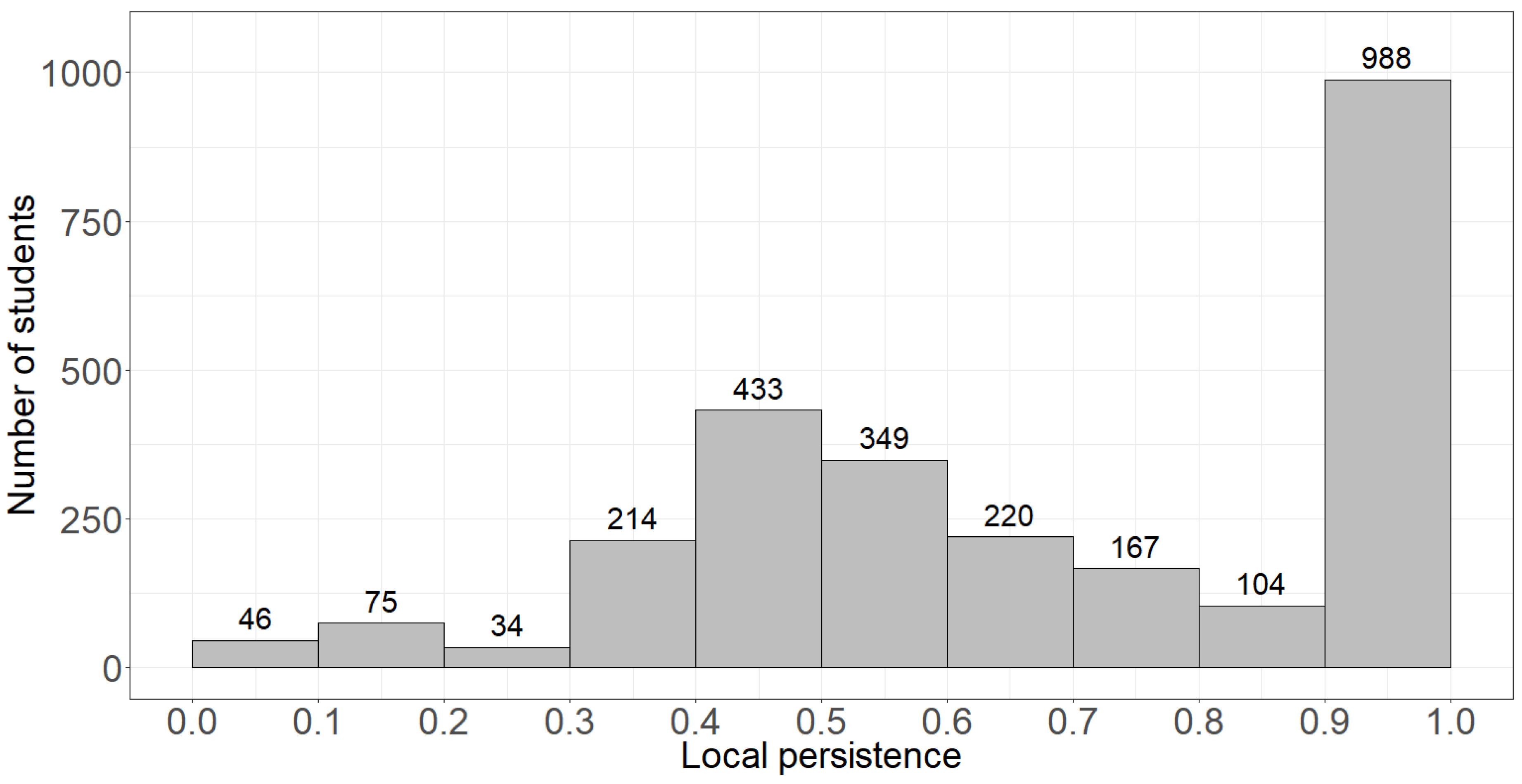
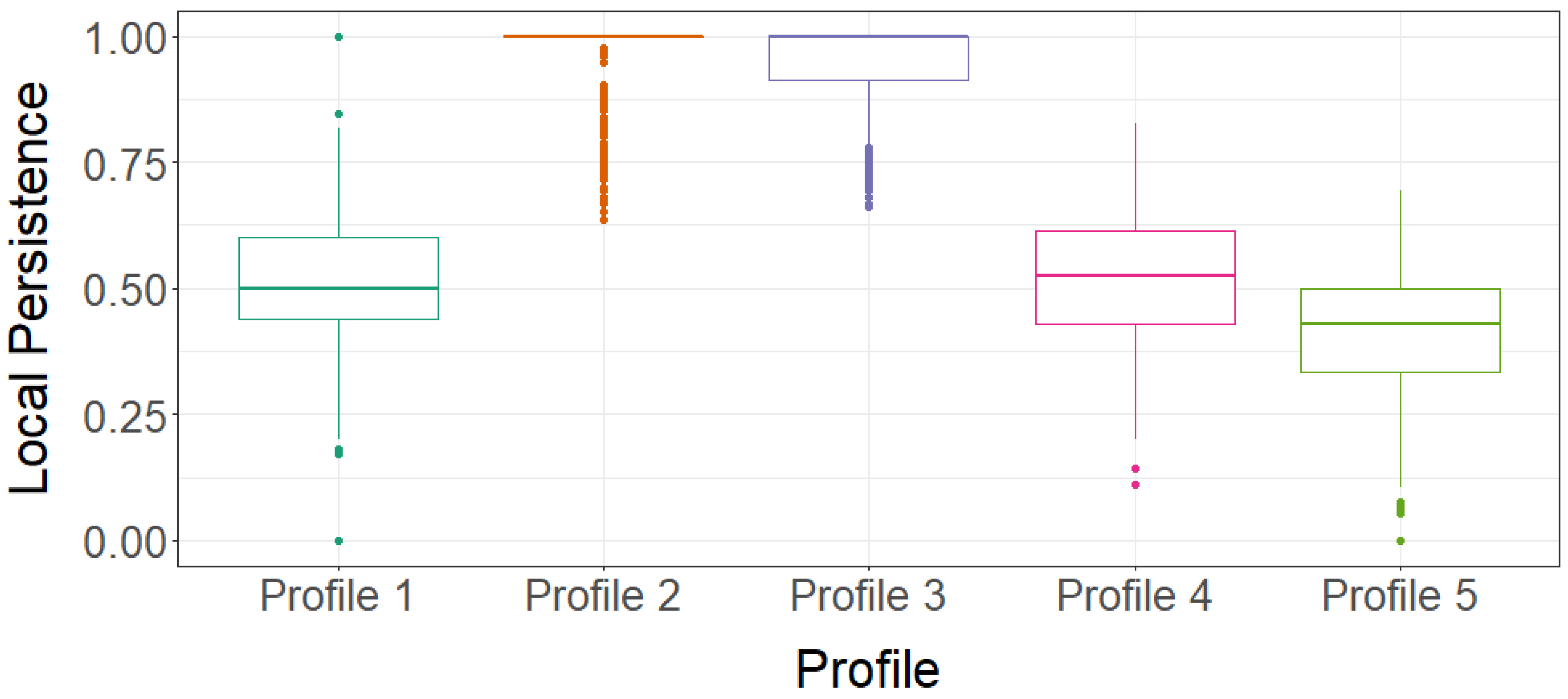
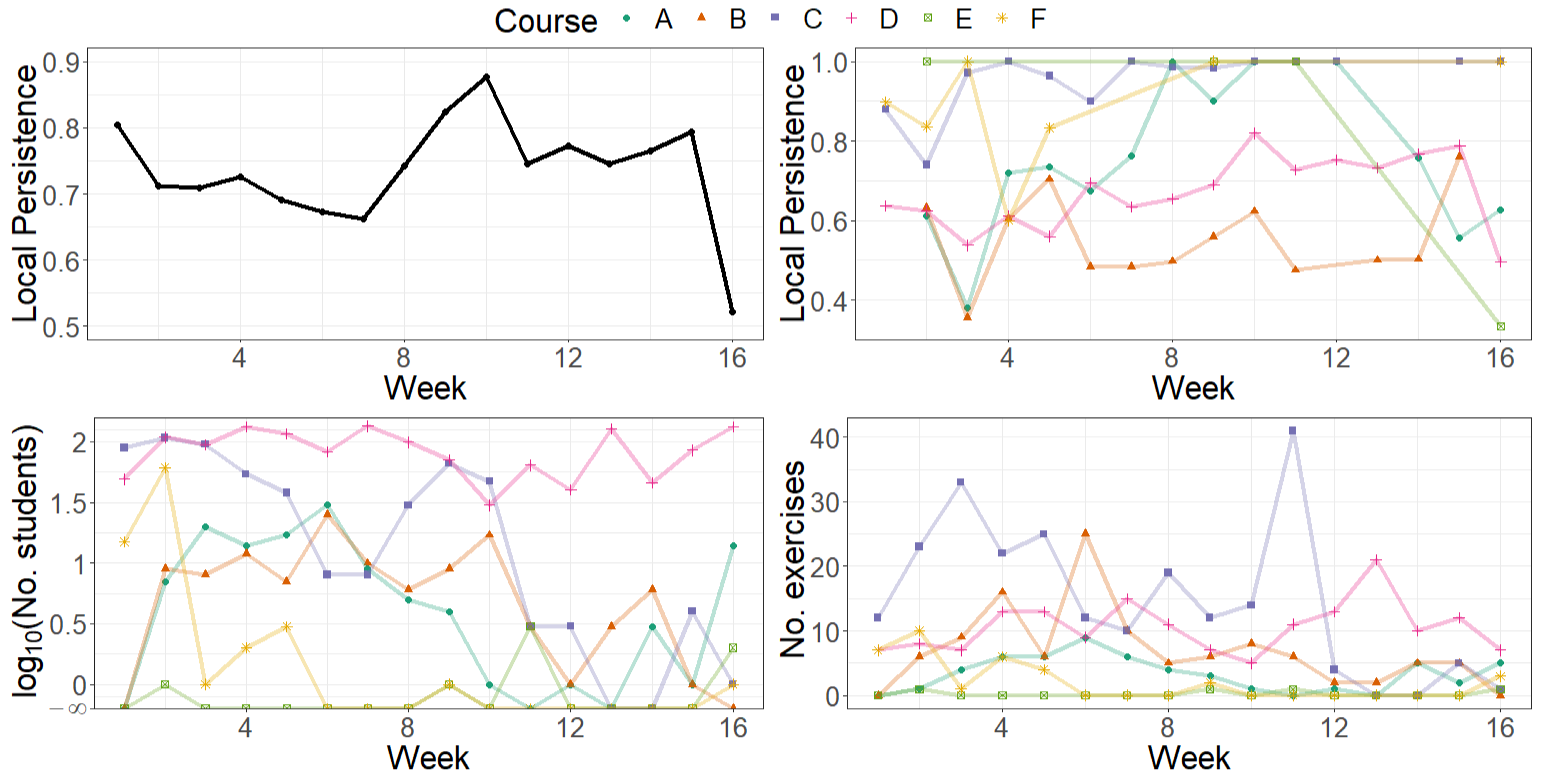
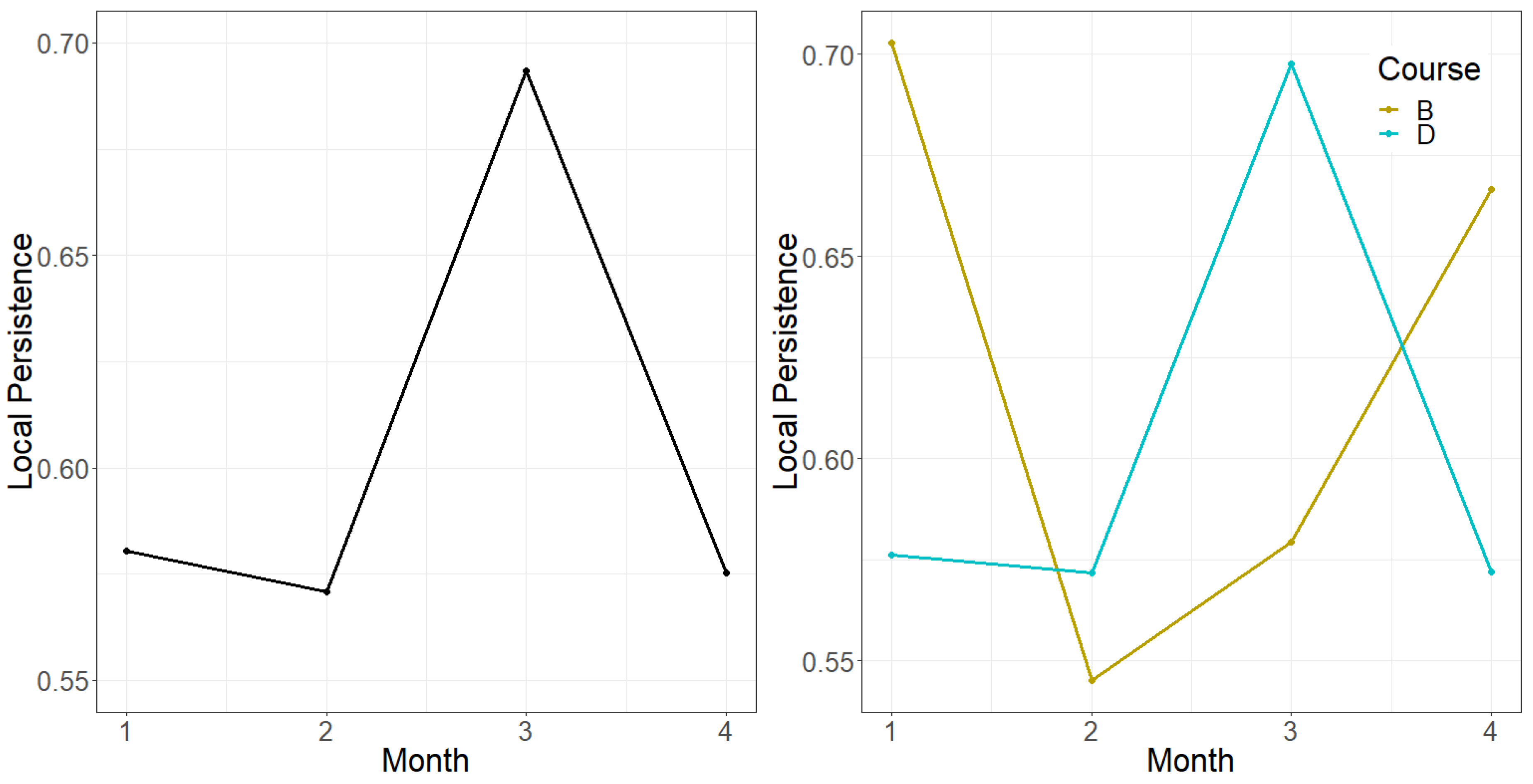
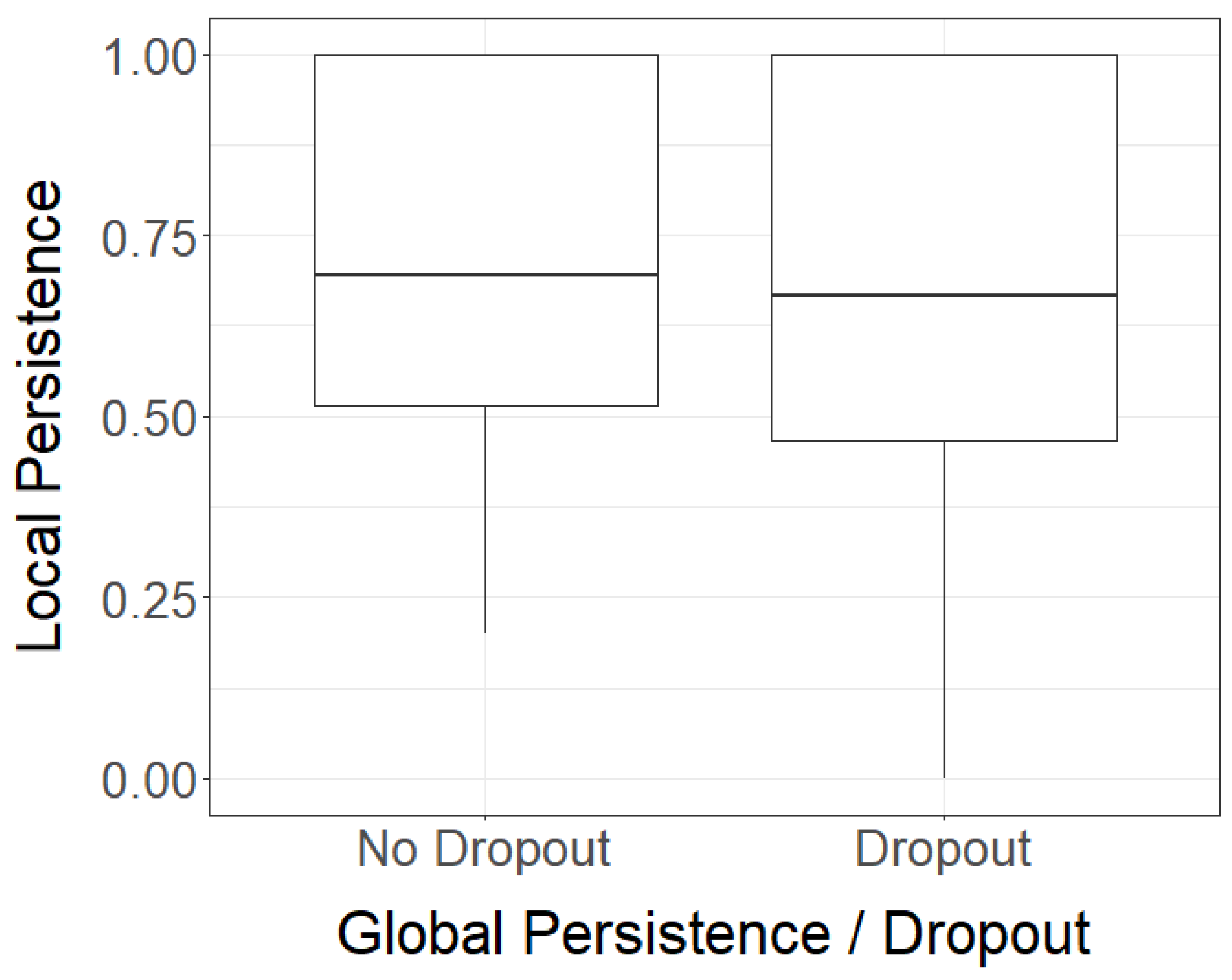
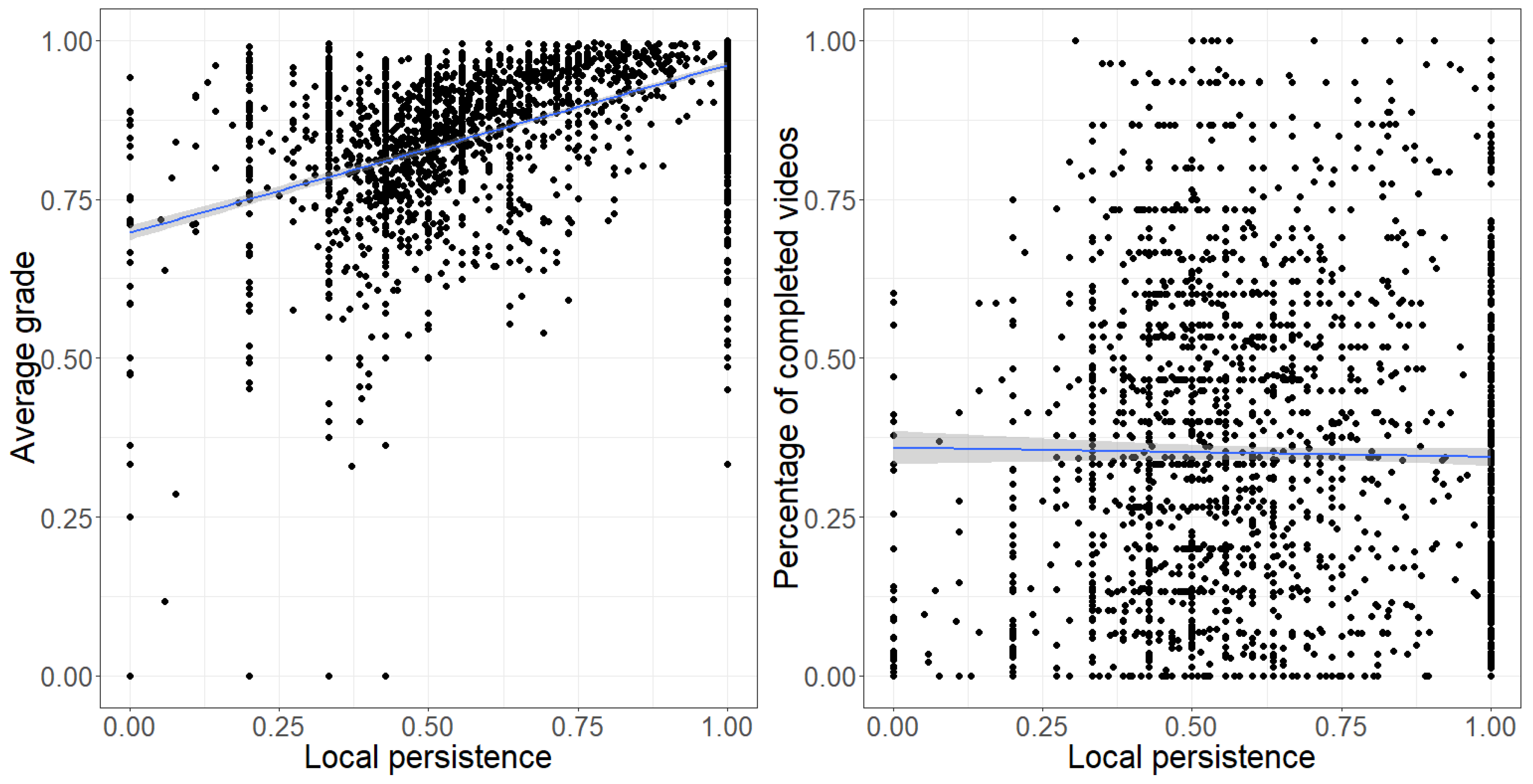
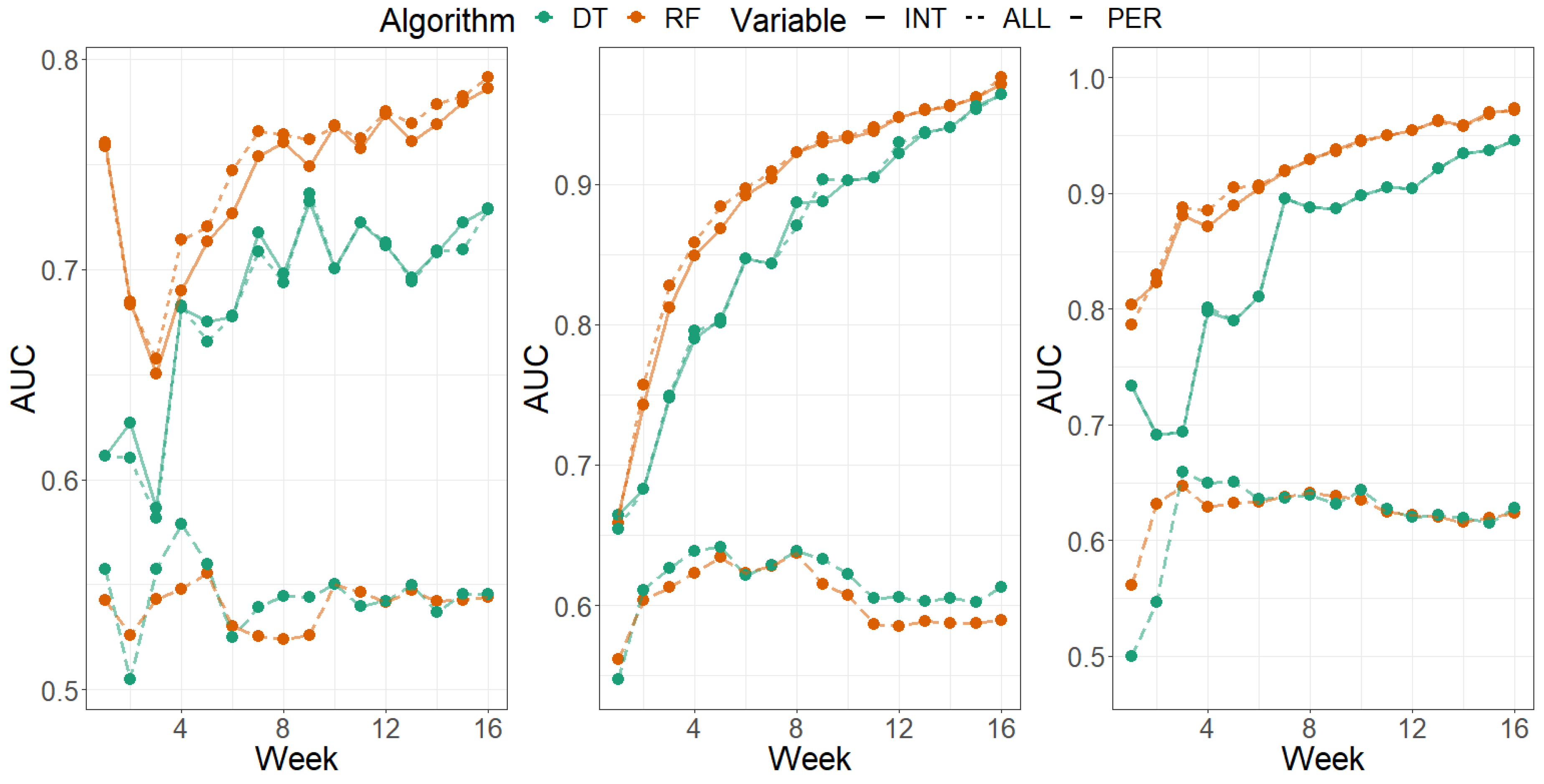
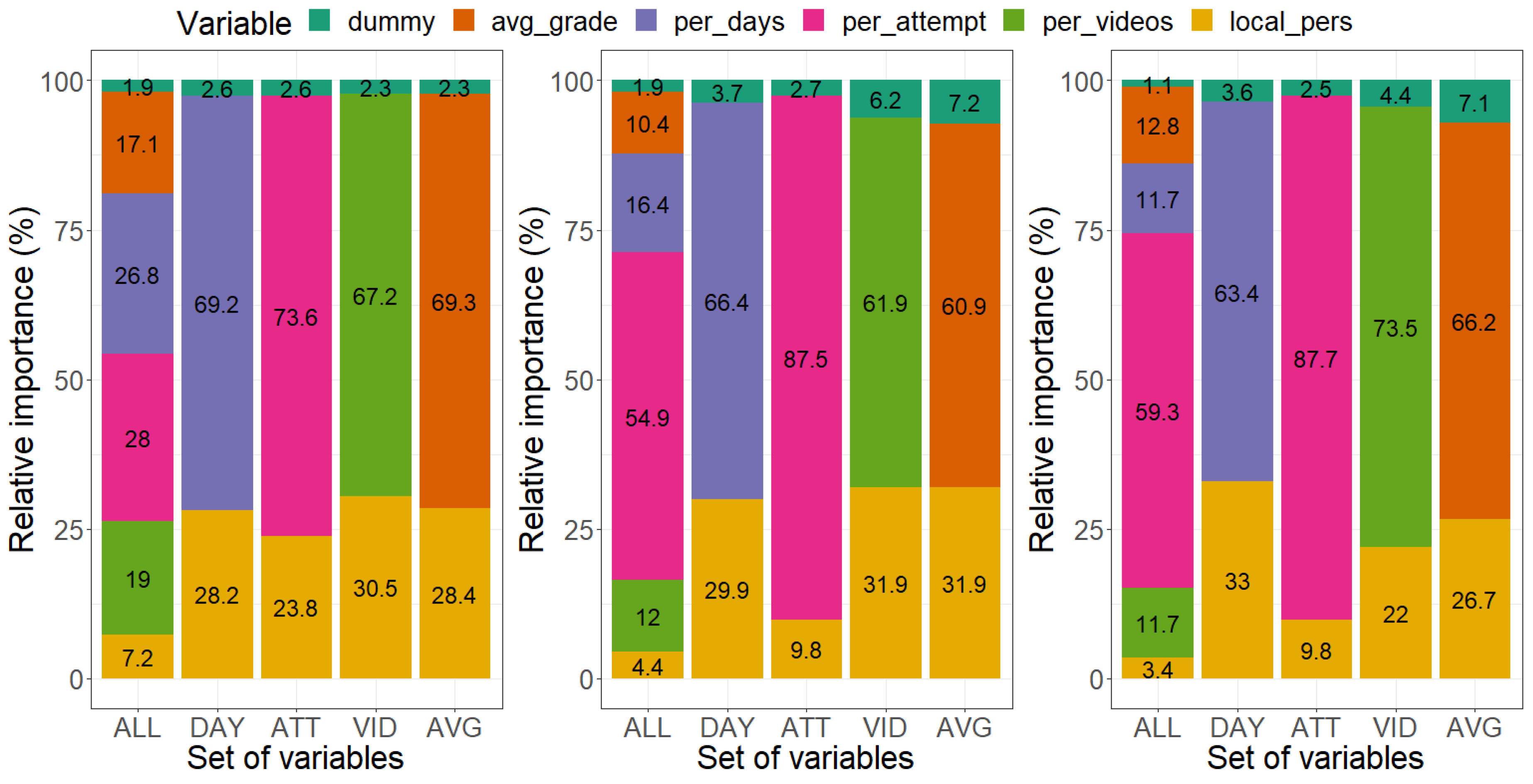
| Category | Variable | Description |
|---|---|---|
| Activity | per_days | Percentage of days the student has accessed to the platform |
| Videos | per_videos | Percentage of completed videos |
| Exercises | per_attempt | Percentage of attempted exercises over the total available |
| Exercises | avg_grade | Average grade of exercises (only using attempted exercises and all the attempts) |
| Persistence | local_pers | Local persistence (Section 4 gives details on how it is computed) |
| ID | Sequence | Idea of Local Persistence |
|---|---|---|
| 1 | 0 | The student is not persistent as s/he does not try the exercise again (after getting 0) in order to get correct answer. |
| 2 | 0 1 | The student shows local persistence as s/he attempts the exercise again to get it right. |
| 3 | 0 0 0 0 0 1 | The student shows local persistence and s/he shows more local persistence than in case 2 as s/he needed a lot of attempts until getting the answer right. |
| 4 | 0 0 0 0 | The student shows certain local persistence as s/he has tried the exercise several times, but s/he has not got the correct answer. Local persistence should be greater than in case 1 but smaller than in cases 2 and 3. |
| ID | Sequence | Attempts | Grade | Local Persistence (Accumulated) |
|---|---|---|---|---|
| 1 | 0 | 1 | 0 | |
| 2 | 0 1 | 2 | 1 | |
| 3 | 0 0 0 0 0 1 | 6 | 1 | |
| 4 | 0 0 0 0 | 4 | 0 |
| Profile | No. Students (%) | Local_Pers | Per_Attempt | Per_Videos | Avg_Grade | lp_5_95 |
|---|---|---|---|---|---|---|
| 1 | 307 (12%) | 0.53 | 0.62 | 0.62 | 0.84 | 0.33–0.77 |
| 2 | 594 (23%) | 0.96 | 0.16 | 0.16 | 0.94 | 0.71–1.00 |
| 3 | 578 (23%) | 0.95 | 0.50 | 0.50 | 0.96 | 0.73–1.00 |
| 4 | 604 (24%) | 0.52 | 0.40 | 0.40 | 0.86 | 0.32–0.71 |
| 5 | 461 (18%) | 0.39 | 0.16 | 0.16 | 0.76 | 0.00–0.60 |
| Name | Variables |
|---|---|
| ALL | per_days/per_videos/avg_grade/per_attempt/local_pers (+dummy variable) |
| DAY | per_days/local_pers (+dummy variable) |
| ATT | per_attempt/local_pers (+dummy variable) |
| VID | per_videos/local_pers (+dummy variable) |
| AVG | avg_grade/local_pers (+dummy variable) |
© 2020 by the authors. Licensee MDPI, Basel, Switzerland. This article is an open access article distributed under the terms and conditions of the Creative Commons Attribution (CC BY) license (http://creativecommons.org/licenses/by/4.0/).
Share and Cite
Moreno-Marcos, P.M.; Muñoz-Merino, P.J.; Alario-Hoyos, C.; Delgado Kloos, C. Re-Defining, Analyzing and Predicting Persistence Using Student Events in Online Learning. Appl. Sci. 2020, 10, 1722. https://doi.org/10.3390/app10051722
Moreno-Marcos PM, Muñoz-Merino PJ, Alario-Hoyos C, Delgado Kloos C. Re-Defining, Analyzing and Predicting Persistence Using Student Events in Online Learning. Applied Sciences. 2020; 10(5):1722. https://doi.org/10.3390/app10051722
Chicago/Turabian StyleMoreno-Marcos, Pedro Manuel, Pedro J. Muñoz-Merino, Carlos Alario-Hoyos, and Carlos Delgado Kloos. 2020. "Re-Defining, Analyzing and Predicting Persistence Using Student Events in Online Learning" Applied Sciences 10, no. 5: 1722. https://doi.org/10.3390/app10051722
APA StyleMoreno-Marcos, P. M., Muñoz-Merino, P. J., Alario-Hoyos, C., & Delgado Kloos, C. (2020). Re-Defining, Analyzing and Predicting Persistence Using Student Events in Online Learning. Applied Sciences, 10(5), 1722. https://doi.org/10.3390/app10051722






